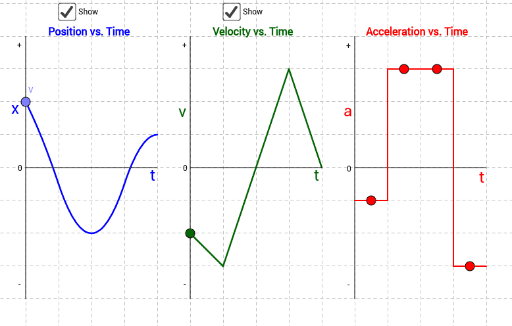It is the average acceleration, which in the case of u.a.r.m. Acceleration (a) is the rate of change of velocity (v) with respect to time (t) or a = dv/dt the formula for average acceleration during an interval of time is average acceleration = (final.

Acceleration-Time Graphs - Ib Physics - Youtube
Click ‘start quiz’ to begin!

Acceleration over time graph. She has over 10 years of experience developing stem curriculum and teaching physics, engineering,. Learn how to calculate speed, velocity and acceleration. In this case, value of velocity will be maximum at the last point of time.
Jerk is most commonly denoted by the symbol j and expressed in m/s 3 ( si units) or standard gravities per second (. It is a vector quantity (having both magnitude and direction). By looking a speed vs.
Acceleration on a position vs. The graphical representation of acceleration over time can be derived through the graph of an object's position over time. Acceleration using a velocity time graph example problems with solutions example 1.
Find out how to use distance time graphs and velocity time graphs with bbc bitesize gcse physics. In the above graph, the velocity corresponding to time = 5 s, is the highest. Or metre per second per second, as the velocity in metres per second changes by the acceleration value, every second.
Acceleration is defined as, δ a = δ v δ t by multiplying both sides of the equation by the change in time δt, we get δ v = a δ t substituting the values in the above equation,. In physics, jerk or jolt is the rate at which an object's acceleration changes with respect to time. Test your knowledge on graphs put your understanding of this concept to test by answering a few mcqs.
Here's what an acceleration vs time graph might look like for a moving particle: What is the acceleration of the van? More realistic motion maps in the real world, acceleration is frequently not constant.
A = f / m, where: The graph below shows a constant acceleration of 4 m/s 2 for a time of 9 s. A is the acceleration, v_i and v_f are respectively the initial and final velocities, δt is the acceleration time, δd is the distance traveled during acceleration, f is the net force acting on an object that accelerates, m is the mass of this object.
L t −2.the si unit of acceleration is the metre per second squared (m s −2); The units of acceleration are m/s/s or m/s2. Acceleration on a speed vs.
Now you know how to calculate acceleration! Acceleration can be calculated by dividing the change in velocity (measured in metres per second) by the time taken for the change (in seconds). An object moving in a circular motion—such as a satellite orbiting the earth—is accelerating due.
The acceleration at time 0 is 0, then becomes positive, and finally, at 9 seconds, it returns back to 0. Often, to show how the acceleration of a particle changes over time, an acceleration vs time graph is used. Learning objectives distinguish the difference between how to plot a velocity graph and how to plot an acceleration graph key takeaways key points acceleration is the rate at which the velocity of a body changes with time.
Is the same as the instantaneous acceleration. Acceleration has the dimensions of velocity (l/t) divided by time, i.e.

Kinematics Graphs: Adjust The Acceleration – Geogebra

Motion Graphs: Position, Velocity & Acceleration (W/ Diagram)